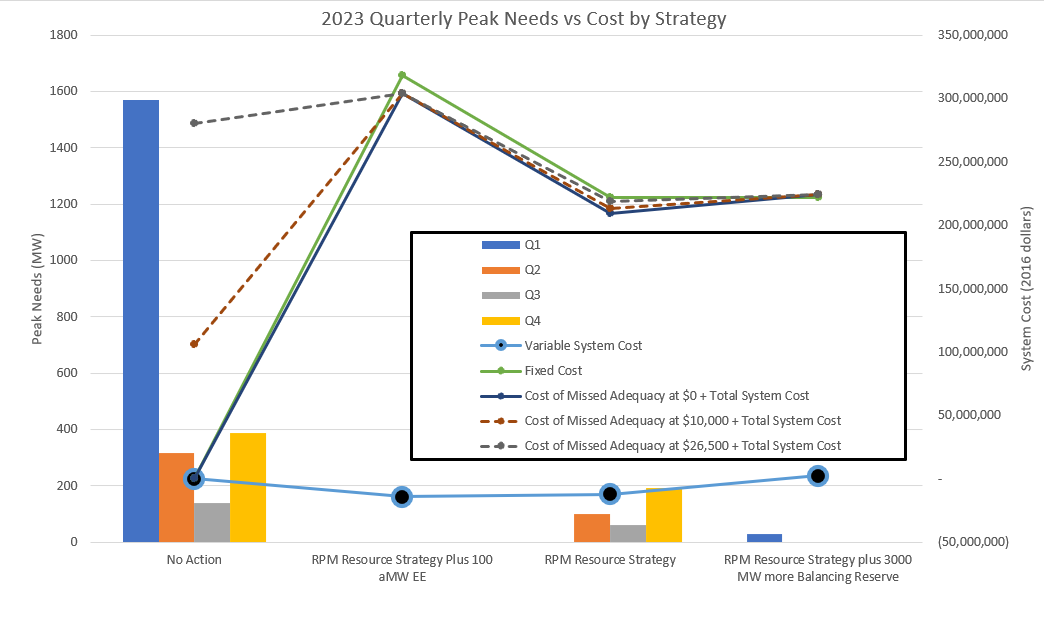Ensuring that the Council’s long-term resource strategy will lead to adequate supplies is a separate issue from assessing the adequacy of the existing power system. Although similar, an adequacy assessment for a resource strategy differs in significant ways. First, a resource strategy spans a much longer period, namely 20 years. Second, a strategy implies that resource development will be dynamic, in other words, resource development depends on what future conditions are encountered. The adequacy of a single resource plan (i.e., the resource construction dates for a specific future) can be assessed, but that is not the same as assessing the adequacy of the strategy itself.
To test that the Adequacy Reserve Margin requirement has produced an adequate resource strategy, the LOLP for specific future years and specific resource acquisitions is assessed. The test is considered successful if the LOLP is close to the Council’s five percent standard in the near term. In practice, however, due to the “lumpiness” of resource size and due to lead-time considerations and uncertainty in demand, a test would be considered successful if the resulting LOLP falls within a range between zero and five percent.
Fundamentally, the reason there is a check is that the combination of the adequacy reserve margin, associated system capacity contribution and associated hydro generation are imperfect at translating all the nuance of system operations to the Regional Portfolio Model. The check ensures that metrics are working appropriately to create an adequate resource strategy.
Since most of the peak needs were showing up on a near term basis, multiple checks were performed to check whether the resource strategy coming out of the Regional Portfolio Model was adequate. At a high level, the results did not quite eliminate all the needs without some small adjustments to the strategy. The Regional Portfolio Model approximates thermal dispatch based on distributional dispatch which likely will result in more flexible dispatch than is possible due to complexities of thermal unit commitment when prices show significant intraday variation.
These adjustments were presented to the System Analysis Advisory Committee and the Council during discussion of the cost effective reserve methodology and the graph of the adequacy check process below. During these discussions, there were a few major options to tweak some of the resource strategy results to maintain an adequate system.
- The least-cost option to maintain an adequate, cost-effective regional system is to couple the investment recommendations (per the listed amounts of renewable generation, energy efficiency, and demand response) in the recommended resource strategy with increased reserves (a more conservative operation of the existing system) through an organized market or regional collaboration. This would ensure that sufficient reserves[1] could be held to mitigate the uncertainty brought about by the increased investment in renewable generation. Part of the reason this method is recommended as the most cost-effective is that the number of reserves necessary to maintain an adequate system could be changed to match needs over time.
- Another more expensive, but effective, alternative is to invest in more energy efficiency than is identified in the resource strategy analysis. This would increase the fixed-cost investments required by the region but may be necessary to maintain adequacy should regional coordination to provide additional reserves prove unsuccessful.
- Another less expensive, but riskier alternative is to plan on importing more power from outside the Northwest in times of need. Other regions have varying policies and requirements, and Northwest stakeholders have less say in those planning processes. Without a more formalized collaborative process like an organized market, this strategy, while taking advantage of the diversity of a large pool of existing resources, would likely expose the region to significantly more risk.
Adequacy Check

Additional checks to the resource strategy were performed after incorporating feedback about hydro system operations from regional stakeholders during an August 2021 technical conference into the analysis. These post draft resource strategy checks showed results consistent to the results from checks performed in the draft analysis.
[1] Analysis showed that over 3,000 megawatts of additional reserves may be required by 2023 to encourage sufficient generation to be online to meet the morning and evening ramps.


